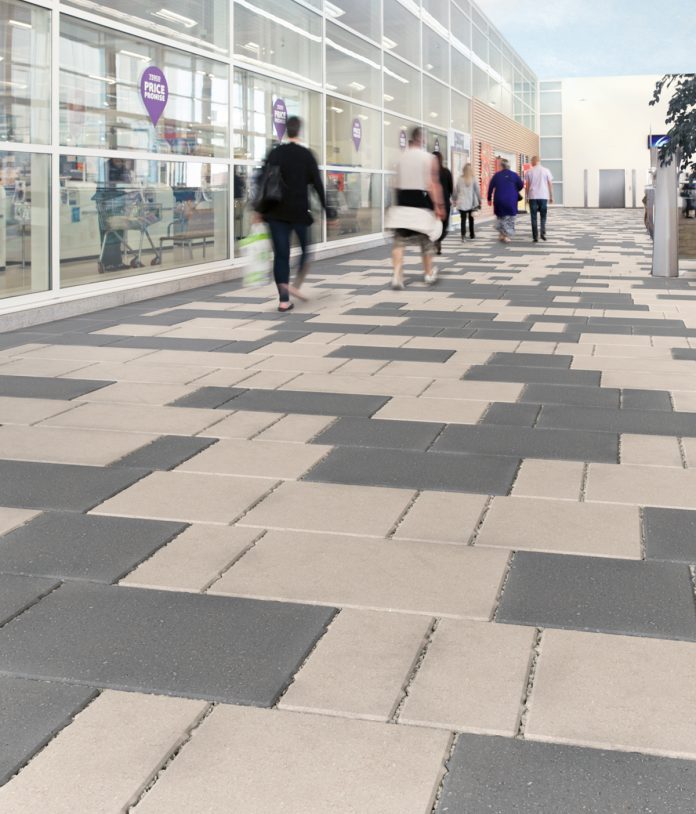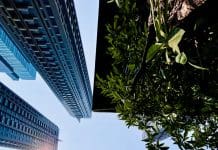Chris Griffiths, Marshalls SuDS Marketing Development Manager, discusses the vital role SuDS plays in our built environment
Traditionally, drainage techniques were developed to direct surface water away from specific areas (such as dwellings) and keep spaces safe, clean and easy to manage. However, as we continue to develop over open green land, there are fewer places for water to go. In addition, we are experiencing more extreme weather events (it’s raining more intensely, for longer, and more frequently). These factors combine to create the devastating flooding events which we see on an increasingly regular basis.
Sustainable Drainage Systems (or SuDS) are a series of design methods and philosophies which aim to emulate natural drainage processes. The principle idea is that rainwater should be collected where it lands, and instead of channelling it away as quickly as possible it should be held back and released at a controlled rate. This reduces the peak flows that occur during a storm event, meaning that existing sewers and water courses are better able to cope with the demand.
Another key advantage SuDS have over traditional drainage techniques is their ability to improve water quality. As surface water travels over roads or pathways, it frequently picks up a variety of both chemical and biological pollutants. In a traditional drainage system, this dirty water then needs to be transported to a different location to be treated; however, in a Sustainable system, many of the pollutants are removed and the water is cleansed as it flows through the system.
Broadly, SuDS fall into two categories – hard and soft. The integration of a variety of different techniques usually provides the best solution; a practical, useable space that invites water in and manages it efficiently while also providing an attractive area that people want to spend time in.
In many ways, soft SuDS are the ideal. These include attenuation ponds, rills and swales that have been carved into the landscape to collect volumes of water in a storm event and let it soak naturally down into the ground, where it replenishes the water table.
These are frequently planted with hardy, perennial, drought-resistant vegetation which is selected to survive regardless of the weather conditions. These provide a number of benefits. The vegetation not only slows down the flow of water by creating a “leaky dam”, but also maximise the cleansing potential of the system. They can create screens that hide less attractive, functional elements of the landscape, or alternatively they can be designed to be an attractive feature in their own right. As well as creating pleasant features for people to enjoy, well-planted SuDS also create environments for wildlife and insects, which help to maintain healthy ecosystems.
However, soft SuDS can take up significant areas of land. This may be simply unavailable, or developers may be unwilling to give over expensive land for such purposes. In these circumstances, “hard SuDS” provide an effective, pragmatic compromise. An example of hard SuDS is permeable paving. There are various different type of permeable paving systems, but all varieties follow the same principle: a hardstanding surface which accepts heavy loads and looks the same as either macadam, concrete or block paving, but also allows rainwater to soak through the surface into the ground below or specially designed storage. Although this kind of system doesn’t provide the biodiversity and amenity benefits of a well-designed soft SuD, it does provide a dual-purpose drainage solution that links an attractive, loadbearing landscaping product with a drainage system that cleans and stores large volumes of water.
Permeable Block Paving is one of the most popular forms of permeable surfacing. It comprises concrete units which fit together to create an attractive paved surface that looks and performs just like ordinary block paving. However, special nibs on the side of the blocks create joints through which rainwater flows directly into a specially prepared sub-base. Once there, the water can either infiltrate directly into the ground at source or, if that’s not possible, be channelled away to a receiving water course at a controlled rate.
In addition to removing large volumes of runoff from entering our already overburdened sewers, a combination of mechanical filtering and chemical biodegradation that occurs naturally in the sub-base ensures that pollutants are largely removed from the sub-base before it is released. This combination of reducing water quantity and improving water quality make Permeable Block Pavements an excellent example of good SuDS.
Greater understanding of SuDS, along with the increasingly wide range of products available, mean that landscapers are now changing their approach to water management. Instead of designing water out of their projects, burying it underground and out of sight, enlightened landscape designers are now inviting water into their designs – creating shared spaces which make a feature of the fresh, clean water that flows through them. The ability to blend hard and soft landscaping techniques results in easy to maintain places which are as functional as they are beautiful.
For further information, go to www.marshalls.co.uk/wm.
Chris Griffiths
SuDS Marketing Development Manager
Tel: (+44) 01422 312000
chris.griffiths@marshalls.co.uk
www.marshalls.co.uk/commercial
Twitter: @MarshallsCom
Please note: this is a commercial profile.














